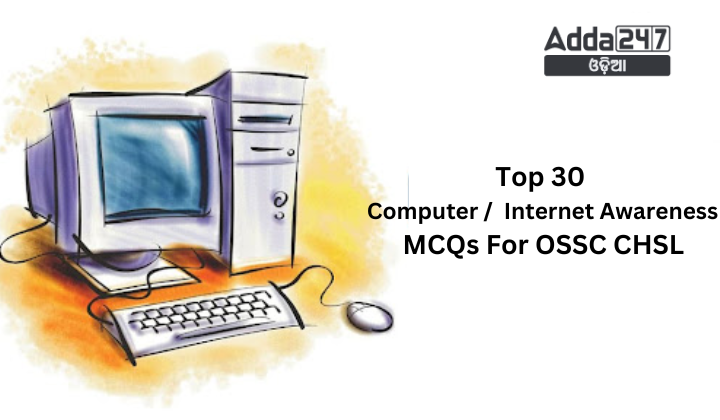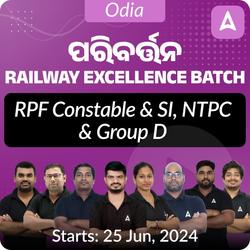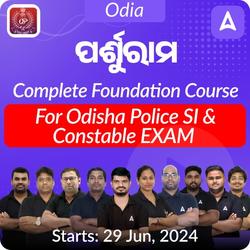The Odisha Staff Selection Commission (OSSC) Combined Higher Secondary Level (CHSL) examination often includes questions on computer fundamentals. Here is a compilation of the top 30 multiple-choice questions (MCQs) to help you prepare effectively for the computer section of the OSSC CHSL exam.
Top 30 Computer / Internet Awareness MCQs For OSSC CHSL
- When was the OSI Model proposed and by which organization was it published?
A) 1970s, International Electrotechnical Commission (IEC)
B) 1980s, International Telecommunication Union (ITU)
C) 1970s, International Organisation of Standardization (ISO)
D) 1980s, Institute of Electrical and Electronics Engineers (IEEE)
Answer: C) 1970s, International Organisation of Standardization (ISO) - What is one of the primary benefits of using the OSI Model in networking?
A) It enhances the speed of the internet
B) It simplifies the troubleshooting process by isolating errors at different levels
C) It increases the storage capacity of devices
D) It improves the battery life of network devices
Answer: B) It simplifies the troubleshooting process by isolating errors at different levels - Who proposed the concept that the OSI Model should be a seven-layer structure?
A) Vint Cerf
B) Bob Kahn
C) Charles Bachman
D) Tim Berners-Lee
Answer: C) Charles Bachman - Why did the OSI Model initially not gain much popularity?
A) It was too complex to implement
B) It did not support the Internet protocol suite
C) It was too expensive to adopt
D) It was not well-documented
Answer: B) It did not support the Internet protocol suite - How are the seven layers of the OSI Model divided?
A) Upper layer (host layer) and lower layer (network layer)
B) Physical layer and logical layer
C) Upper layer (host layer) and lower layer (media layer)
D) Transmission layer and reception layer
Answer: C) Upper layer (host layer) and lower layer (media layer) - What is one of the primary functions of the Physical Layer in the OSI Model?
A) Formatting data
B) Converting digital bits into electrical, radio, or optical signals
C) Managing connections between applications
D) Controlling data flow
Answer: B) Converting digital bits into electrical, radio, or optical signals - What does the Data Link Layer do to the input data for easier analysis?
A) Encrypts the data
B) Converts data into signals
C) Breaks the input data into frames
D) Compresses the data
Answer: C) Breaks the input data into frames - What is a key function of the Network Layer in the OSI Model?
A) Establishing sessions between computers
B) Managing data segmentation and desegmentation
C) Ensuring data is sent to its destination address
D) Formatting data for applications
Answer: C) Ensuring data is sent to its destination address - Which of the following is managed by the Transport Layer?
A) Data encryption
B) Data compression
C) Delivery of data packets
D) Establishing network connections
Answer: C) Delivery of data packets - What is a primary function of the Presentation Layer in the OSI Model?
A) Converting data into syntax or semantics that an application understands
B) Managing network addresses
C) Establishing and terminating connections
D) Controlling data flow and error checking
Answer: A) Converting data into syntax or semantics that an application understands - What was the first network to implement host-to-host interactions?
a) World Wide Web
b) ARPANET
c) Ethernet
d) ISDN
Answer: b) ARPANET - Which organization developed ARPANET?
a) NASA
b) IBM
c) Advanced Research Projects Agency (ARPA) of the Department of Defense, U.S.
d) Microsoft
Answer: c) Advanced Research Projects Agency (ARPA) of the Department of Defense, U.S. - In which decade was the commercial use of the Internet significantly advanced with the miniaturization of transistors and transmitters?
a) 1960s
b) 1970s
c) 1980s
d) 1990s
Answer: b) 1970s - What innovation in the 1980s allowed different machines and networks worldwide to assemble data packets effectively?
a) World Wide Web
b) Ethernet
c) Transmission Control Protocol/Internet Protocol (TCP/IP)
d) Satellite communication
Answer: c) Transmission Control Protocol/Internet Protocol (TCP/IP) - Which development in 1993 significantly improved Internet usability for the general public?
a) Introduction of ARPANET
b) Invention of Ethernet
c) Launch of the web browser
d) Creation of ISDN
Answer: c) Launch of the web browser - What was the main target of the Defence Advanced Research Projects Agency (formerly ARPA) in the development of the Internet?
a) Developing high-speed broadband
b) Satellite-based radio packets for mobile network usage
c) Establishing ISDN
d) Creating the World Wide Web
Answer: b) Satellite-based radio packets for mobile network usage - Which decade saw the emergence of thousands of Internet Service Providers, particularly in the U.S.?
a) 1970s
b) 1980s
c) 1990s
d) 2000s
Answer: c) 1990s - What major development in the 21st century greatly enhanced Internet accessibility?
a) Dial-up connections
b) Broadband over cable
c) Wireless broadband services
d) ISDN services
Answer: c) Wireless broadband services - Which protocol is used for transferring hypertext across multiple devices on the Internet?
a) File Transfer Protocol (FTP)
b) Hypertext Transfer Protocol (HTTP)
c) TCP/IP
d) Integrated Services Digital Network (ISDN)
Answer: b) Hypertext Transfer Protocol (HTTP) - What type of Internet connection uses telephone lines to send audio or video data?
a) Dial-up
b) Broadband
c) Integrated Services Digital Network (ISDN)
d) Satellite
Answer: c) Integrated Services Digital Network (ISDN) - What type of memory is directly accessible by the CPU?
a) Secondary Storage
b) Tertiary Storage
c) Primary Storage
d) None of the above
Answer: c) Primary Storage - Which storage device uses magnetic elements to store data?
a) CD-ROM
b) USB Drive
c) Floppy Disk
d) SD Card
Answer: c) Floppy Disk - What is the primary characteristic of secondary storage?
a) Volatile
b) Non-volatile
c) Temporary
d) None of the above
Answer: b) Non-volatile - Which storage device is known for using lasers to read data?
a) Hard Drive
b) Blu-Ray Disc
c) Memory Card
d) Magnetic Strip
Answer: b) Blu-Ray Disc - What is the typical storage capacity of a Blu-Ray disc in a dual-layer format?
a) 25 GB
b) 50 GB
c) 100 GB
d) 500 GB
Answer: b) 50 GB - Which of the following is not a type of flash memory device?
a) USB Drive
b) Hard Drive
c) Memory Card
d) Memory Stick
Answer: b) Hard Drive - Which storage device is commonly used in digital cameras?
a) Zip Disk
b) Magnetic Strip
c) SD Card
d) DVD
Answer: c) SD Card - What is the main disadvantage of primary storage?
a) It is slow
b) It is volatile
c) It is non-volatile
d) It is expensive
Answer: b) It is volatile - Which type of storage device can be rewritten multiple times?
a) CD-ROM
b) DVD-R
c) CD-R
d) DVD-RW
Answer: d) DVD-RW - Which device was introduced by Iomega with a storage space initially of 100 MB?
a) Zip Disk
b) Hard Drive
c) Floppy Disk
d) USB Drive
Answer: a) Zip Disk










